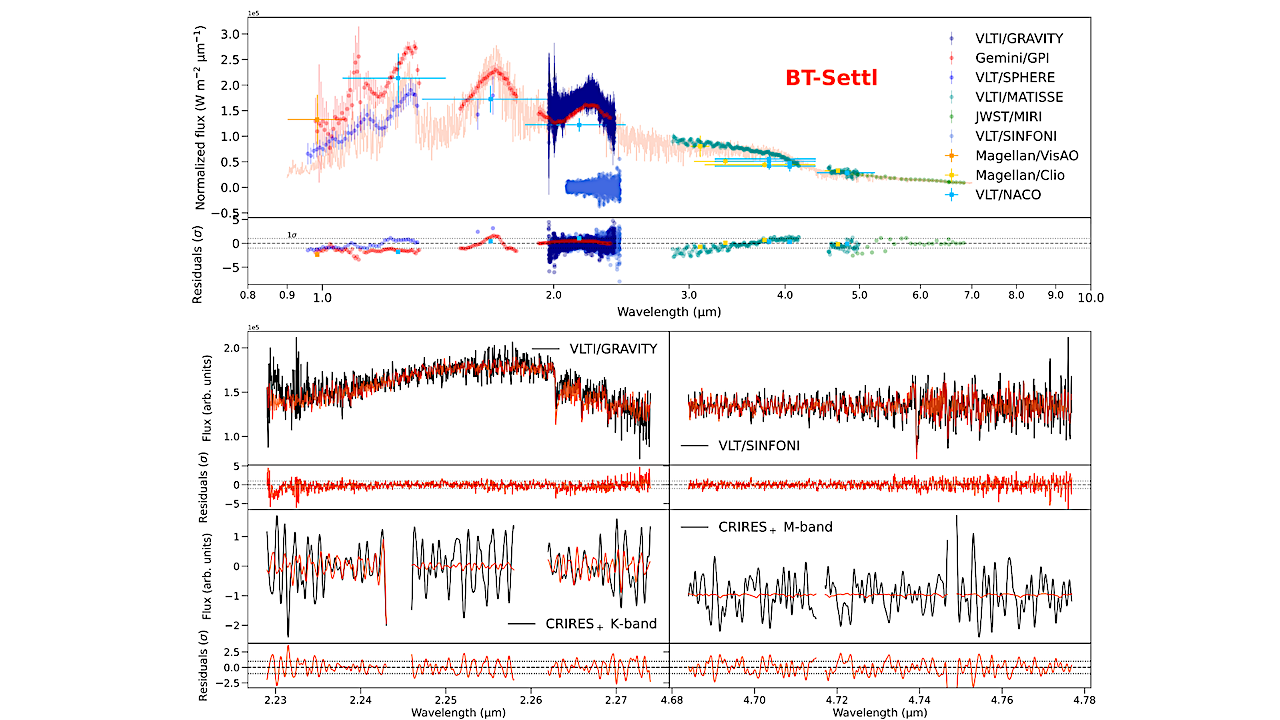Science
Astronomers Unveil Insights from β Pictoris b Using GRAVITY

Researchers have made significant strides in understanding the exoplanet β Pictoris b by utilizing the Very Large Telescope Interferometer (VLTI) and its advanced GRAVITY instrument. These observations represent the first high-resolution continuum spectra recorded for this distant world, providing new insights into its atmospheric composition and physical characteristics.
The observations yielded four high signal-to-noise K-band spectra, each demonstrating a signal-to-noise ratio of approximately 20. These spectra effectively preserved both the pseudo-continuum and the molecular absorption patterns crucial for analysis. The research team, led by M. Ravet, employed four self-consistent forward model grids—Exo-REM, ATMO, BT-Settl, and Sonora—to explore various parameters, including effective temperature (T eff), surface gravity (log(g)), metallicity, carbon-to-oxygen ratio (C/O), and the ratio of carbon isotopes (12 CO/13 CO).
The analysis revealed that the models Sonora and Exo-REM were statistically favored in describing the planet’s atmosphere. The data from GRAVITY alone indicated an effective temperature of 1,607.45 K and a surface gravity log(g) of 4.46. When combining this data with other datasets, the effective temperature was adjusted to 1,502.74 K, while the surface gravity remained consistent at 4.00.
The research also highlighted the influence of archival data on the retrieved atmospheric parameters. The C/O ratio was found to remain solar at approximately 0.552, while the metallicity reached super-solar levels of 0.50. A tentative constraint on the log(12 CO/13 CO) ratio was established at about 1.12, though this finding remains inconclusive due to residual atmospheric interference.
Implications of Findings
The luminosity of β Pictoris b was estimated at -4.01 in logarithmic terms, suggesting a heavy-element content of up to approximately 5%, which translates to a range of 20-80 M⊕ (Earth masses). This estimation is based on the planet’s age and dynamical mass measurements. The research indicates that access to both the continuum and molecular lines at the K-band significantly influences the metallicity readings, likely due to the impact of collision-induced absorption shaping the continuum.
Interestingly, the study found that echelle spectra did not dominate the final fitting process compared to lower-resolution data, suggesting a need for future observational strategies. The authors recommend that upcoming multi-modal frameworks incorporate weighting schemes that account for bandwidth and central wavelength coverage to enhance the accuracy of atmospheric characterizations.
This groundbreaking research is set to be published in the journal A&A and represents a pivotal step in exoplanet studies. The findings not only deepen our understanding of β Pictoris b but also pave the way for future investigations into the atmospheric properties of distant exoplanets.
For those interested in delving deeper into the research, the full study can be accessed through the arXiv repository, with publication officially accepted on September 29, 2025.
-

 Lifestyle5 months ago
Lifestyle5 months agoLibraries Challenge Rising E-Book Costs Amid Growing Demand
-

 Sports4 months ago
Sports4 months agoTyreek Hill Responds to Tua Tagovailoa’s Comments on Team Dynamics
-

 Sports4 months ago
Sports4 months agoLiverpool Secures Agreement to Sign Young Striker Will Wright
-

 Lifestyle4 months ago
Lifestyle4 months agoSave Your Split Tomatoes: Expert Tips for Gardeners
-

 Lifestyle4 months ago
Lifestyle4 months agoPrincess Beatrice’s Daughter Athena Joins Siblings at London Parade
-

 Science4 months ago
Science4 months agoSan Francisco Hosts Unique Contest to Identify “Performative Males”
-

 World4 months ago
World4 months agoWinter Storms Lash New South Wales with Snow, Flood Risks
-

 Science5 months ago
Science5 months agoTrump Administration Moves to Repeal Key Climate Regulation
-

 Business5 months ago
Business5 months agoSoFi Technologies Shares Slip 2% Following Insider Stock Sale
-

 Science5 months ago
Science5 months agoNew Tool Reveals Link Between Horse Coat Condition and Parasites
-

 Sports4 months ago
Sports4 months agoElon Musk Sculpture Travels From Utah to Yosemite National Park
-

 Science5 months ago
Science5 months agoNew Study Confirms Humans Transported Stonehenge Bluestones









